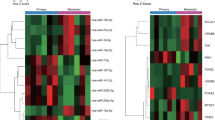Abstract
Cancer stem cells (CSCs) are cancer cells that possess the ability to undergo continuous proliferation and self-renewal. It has been postulated that CSCs are responsible for tumor growth, heterogeneity, invasion, metastasis, and recurrence. MicroRNAs (miRNAs), small non-coding RNAs of approximately 22 nucleotides, are known to be involved in the maintenance of CSCs. To gain insight into the role of miRNAs in CSCs, we investigated the differential expression of miRNAs in ovarian CSCs compared to non-CSCs. Ovarian CSCs were isolated from the human ovarian cancer cell line SK-OV-3 using two ovarian CSC-specific surface markers, CD44 and CD117. The expression levels of miRNAs in CSCs and non-CSCs were estimated by miRNA sequencing. We detected four up-regulated miRNAs (miR-29a-5p, miR-34c-5p, miR-106a-5p, and miR-424-5p) in ovarian CSCs, and miR-424-5p was validated by real-time qPCR. MiR-424-5p target genes were predicted using several validated target databases and computational algorithms. Pathway analysis indicated that most miR-424-5p target genes are involved in cancer-related biological pathways. Overall, these results suggest that miR-424-5p is a potential regulator of CSCs that endows human ovarian tissue with tumorigenic potential and thus represents a potential therapeutic target for human ovarian cancer.



Similar content being viewed by others
References
Alvero AB, Chen R, Fu HH et al (2009) Molecular phenotyping of human ovarian cancer stem cells unravel the mechanisms for repair and chemo-resistance. Cell Cycle 8:158–166
Ashburner M, Ball CA, Blake JA et al (2000) Gene Ontology: tool for the unification of biology. Nat Genet 25:25–29
Bapat SA (2010) Human ovarian cancer stem cells. Reproduction 140:33–41
Bolstad BM, Irizarry RA, Astrand M, Speed TP (2003) A comparison of normalization methods for high density oligonucleotide array data based on variance and bias. Bioinformatics 19:185–193
Chen D, Zhang Y, Wang J, Chen J, Yang C, Cai K, Wang X, Shi F, Dou J (2013a) MicroRNA-200c overexpression inhibits tumorigenicity and metastasis of CD117 + CD44 + ovarian cancer stem cells by regulating epithelial-mesenchymal transition. J Ovarian Res 6:50
Chen J, Wang J, Chen D, Yang J, Yang C, Zhang Y, Zhang H, Dou J (2013b) Evaluation of characteristics of CD44 + CD117 + ovarian cancer stem cells in three dimensional basement membrane extract scaffold versus two dimensional monocultures. BMC Cell Biol 14:7
Deiters A (2010) Small Molecule Modifiers of the microRNA and RNA Interference Pathway. AAPS J 12:51–60
Dennis G, Sherman BT, Hosack DA, Yang J, Gao W, Lane HC, Lempicki RA (2003) DAVID: database for annotation, visualization, and integrated discovery. Genome Biol 4:R60
Di Leva G, Croce CM (2013) The Role of microRNAs in the Tumorigenesis of Ovarian Cancer. Front Oncol 3:153
He L, Hannon GJ (2004) Micrornas: small RNAs with a big role in gene regulation. Nat Rev Genet 5:522–531
Huang DW, Sherman BT, Lempicki RA (2009) Systematic and integrative analysis of large gene lists using DAVID bioinformatics resources. Nat Protoc 4:44–57
Iorio MV, Visone R, Di Leva G et al (2007) MicroRNA signatures in human ovarian cancer. Cancer Res 67:8699–8707
Kanehisa M, Goto S (2000) KEGG: kyoto Encyclopedia of Genes and Genomes. Nucleic Acids Res 28:27–30
Kanehisa M, Goto S, Hattori M, Aoki-Kinoshita KF, Itoh M, Kawashima S, Katayama T, Araki M, Hirakawa M (2006) From genomics to chemical genomics: new developments in KEGG. Nucleic Acids Res 34:D354–D357
Kreso A, Dick JE (2014) Evolution of the Cancer Stem Cell Model. Cell Stem Cell 14:275–291
Li F, Tiede B, Massague J, Kang YB (2007) Beyond tumorigenesis: cancer stem cells in metastasis. Cell Res 17:3–14
Liu C, Tang DG (2011) MicroRNA Regulation of Cancer Stem Cells. Cancer Res 71:5950–5954
Luo LJ, Zeng JF, Liang B, Zhao Z, Sun LL, Cao DY, Yang JX, Shen K (2011) Ovarian cancer cells with the CD117 phenotype are highly tumorigenic and are related to chemotherapy outcome. Exp Mol Pathol 91:596–602
Oneyama C, Kito Y, Asai R et al (2013) MiR-424/503-mediated Rictor upregulation promotes tumor progression. PLOS One 8:e80300
Papagiannakopoulos T, Kosik KS (2008) MicroRNAs: regulators of oncogenesis and stemness. BMC Med 6:15
Park YT, Jeong JY, Lee MJ, Kim KI, Kim TH, Kwon YD, Lee C, Kim OJ, An HJ (2013) MicroRNAs overexpressed in ovarian ALDH1-positive cells are associated with chemoresistance. J Ovarian Res 6:18
Reya T, Morrison SJ, Clarke MF, Weissman IL (2001) Stem cells, cancer, and cancer stem cells. Nature 414:105–111
Wang Z, Gerstein M, Snyder M (2009) RNA-Seq: a revolutionary tool for transcriptomics. Nat Rev Genet 10:57–63
Zaman MS, Maher DM, Khan S, Jaggi M, Chauhan SC (2012) Current status and implications of microRNAs in ovarian cancer diagnosis and therapy. J Ovarian Res 5:13
Zhang S, Balch C, Chan MW, Lai HC, Matei D, Schilder JM, Yan PS, Huang THM, Nephew KP (2008) Identification and characterization of ovarian cancer-initiating cells from primary human tumors. Cancer Res 68:4311–4320
Zhang D, Shi Z, Li M, Mi J (2014) Hypoxia-induced miR-424 decreases tumor sensitivity to chemotherapy by inhibiting apoptosis. Cell Death Dis 5:6
Acknowledgments
This research was supported by a National Research Foundation of Korea (NRF) grant funded by the Korea government (MEST) (2012M3A9D1054534), the Hallym University Specialization Fund (HRF-S-11), and an intramural grant from the Korea Institute of Science and Technology (2z04381).
Conflict of interest
The authors declare no conflicts of interest.
Ethical statement
In this study, human ovarian cancer cells were obtained from the commercially available human ovary adenocarcinoma (ATCC® HTB-77™). This study was approved by Hallym University Institutional Review Board (HIRB).
Author information
Authors and Affiliations
Corresponding authors
Additional information
Ji Ho Yun and Jisun Lim have contributed equally to co-first authors.
Electronic supplementary material
Below is the link to the electronic supplementary material.
Rights and permissions
About this article
Cite this article
Yun, J.H., Lim, J., Ha, I.S. et al. MicroRNA sequencing detects miR-424-5p up-regulation in ovarian cancer stem cells. Genes Genom 37, 737–742 (2015). https://doi.org/10.1007/s13258-015-0299-9
Received:
Accepted:
Published:
Issue Date:
DOI: https://doi.org/10.1007/s13258-015-0299-9




